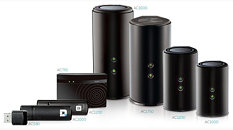Tuesday, May 14th 2013

D-Link Now Shipping New Lineup of 11AC Routers
D-Link today announced it is now shipping a new line of AC Routers with the availability of the Wireless AC1750 Router (DIR-868L), Wireless AC1200 Router (DIR-860L), Wireless AC1000 Router (DIR-820L) and Wireless AC750 Router (DIR-810L). Offering next-generation Wi-Fi speeds, D-Link's latest 802.11ac Routers deliver a range of wireless speeds and price points for creating a reliable and strong Wi-Fi home network ideal for HD video streaming, online gaming, and multiple user activities.
"Today's average home now has more than 15 devices, oftentimes with multiple iPads, iPhones, as well as Android phones and tablets, and consumers are looking for the best in wireless connectivity to help deliver uninterrupted HD video streaming, online gaming and multiple user capabilities," said Daniel Kelley , vice president of marketing, D-Link Systems, Inc. "With the introduction of the new 11AC Router line, D-Link provides next-generation wireless speeds to meet the needs of the digital home coupled with advanced remote management and sharing capabilities to better suit mobile lifestyles."The Wireless AC1750 Dual Band Gigabit Cloud Router and Wireless AC1200 Dual Band Gigabit Cloud Router deliver speeds of up to 1750 Mbps (N450 Mbps + AC1300 Mbps) and 1200 Mbps (N300 + AC867 Mbps) respectively. In addition, the Wireless AC1000 Dual Band Cloud Router offers speeds of up to 1000 Mbps (N300 Mbps + AC650 Mbps) and the Wireless AC750 Dual Band Cloud Router offers speeds of up to 750 Mbps (N300 Mbps + AC433 Mbps). Eliminating Wi-Fi interference for faster and more reliable Internet, D-Link's family of AC routers are equipped with Dual Band technology enabling users to perform simple Internet activities on the 2.4 GHz band, and more demanding activities on the cleaner, interference free 5 GHz band. The routers are also backward compatible with 802.11a/b/g/n devices for seamless connectivity.
Offering easy remote network management, the Cloud Routers enable users to see what websites are being visited, block unwanted connections, and set up automatic email alerts when unauthorized connections are made on any iPhone, iPad or Android device with the free mydlink Lite app. In addition, the routers feature a USB port that works with the free SharePort mobile app, enabling users to stream and share photos, music and movie files directly to their mobile device. The AC routers also support easy setup using a mobile phone or tablet with the free Quick Router Setup (QRS) app.
For fast wired connectivity, the Wireless AC1750 Dual Band Gigabit Cloud Router and AC1200 Dual Band Gigabit Cloud Router are equipped with four Gigabit Ethernet ports and the Wireless AC1000 Dual Band Cloud Router and AC750 Dual Band Cloud Router are equipped with four Fast Ethernet ports.
Availability and Pricing
The new line of AC routers will be available throughout D-Link's vast network of retail and e-tail outlets in the United States. Detailed specifications and information are available online at www.dlink.com with street pricing as follows:
"Today's average home now has more than 15 devices, oftentimes with multiple iPads, iPhones, as well as Android phones and tablets, and consumers are looking for the best in wireless connectivity to help deliver uninterrupted HD video streaming, online gaming and multiple user capabilities," said Daniel Kelley , vice president of marketing, D-Link Systems, Inc. "With the introduction of the new 11AC Router line, D-Link provides next-generation wireless speeds to meet the needs of the digital home coupled with advanced remote management and sharing capabilities to better suit mobile lifestyles."The Wireless AC1750 Dual Band Gigabit Cloud Router and Wireless AC1200 Dual Band Gigabit Cloud Router deliver speeds of up to 1750 Mbps (N450 Mbps + AC1300 Mbps) and 1200 Mbps (N300 + AC867 Mbps) respectively. In addition, the Wireless AC1000 Dual Band Cloud Router offers speeds of up to 1000 Mbps (N300 Mbps + AC650 Mbps) and the Wireless AC750 Dual Band Cloud Router offers speeds of up to 750 Mbps (N300 Mbps + AC433 Mbps). Eliminating Wi-Fi interference for faster and more reliable Internet, D-Link's family of AC routers are equipped with Dual Band technology enabling users to perform simple Internet activities on the 2.4 GHz band, and more demanding activities on the cleaner, interference free 5 GHz band. The routers are also backward compatible with 802.11a/b/g/n devices for seamless connectivity.
Offering easy remote network management, the Cloud Routers enable users to see what websites are being visited, block unwanted connections, and set up automatic email alerts when unauthorized connections are made on any iPhone, iPad or Android device with the free mydlink Lite app. In addition, the routers feature a USB port that works with the free SharePort mobile app, enabling users to stream and share photos, music and movie files directly to their mobile device. The AC routers also support easy setup using a mobile phone or tablet with the free Quick Router Setup (QRS) app.
For fast wired connectivity, the Wireless AC1750 Dual Band Gigabit Cloud Router and AC1200 Dual Band Gigabit Cloud Router are equipped with four Gigabit Ethernet ports and the Wireless AC1000 Dual Band Cloud Router and AC750 Dual Band Cloud Router are equipped with four Fast Ethernet ports.
Availability and Pricing
The new line of AC routers will be available throughout D-Link's vast network of retail and e-tail outlets in the United States. Detailed specifications and information are available online at www.dlink.com with street pricing as follows:
- Wireless AC 1750 Dual Band Gigabit Cloud Router (DIR-868L) - $169.99
- Wireless AC 1200 Dual Band Gigabit Router (DIR-860L) - $149.99
- Wireless AC1000 Dual Band Cloud Router (DIR-820L) - $119.99
- Wireless AC750 Dual Band Cloud Router (DIR-810L ) - $79.99

6 Comments on D-Link Now Shipping New Lineup of 11AC Routers
en.wikipedia.org/wiki/802.11ac#New_scenarios_and_configurations
www.dlink.com/-/media/Consumer_Products/DIR/DIR%20868L/Manual/DIR868LA1manual042213v1.pdf